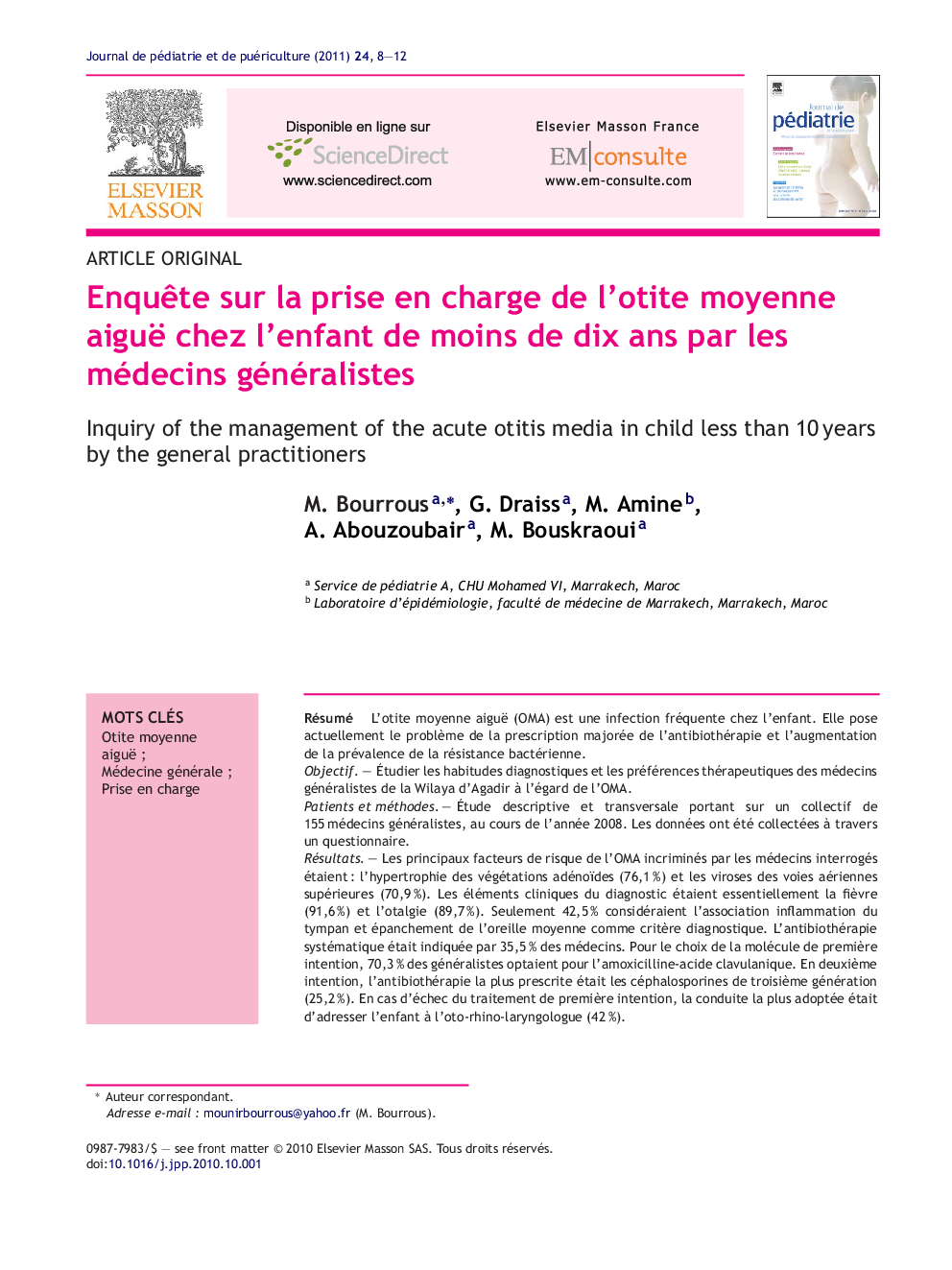| Article ID | Journal | Published Year | Pages | File Type |
|---|---|---|---|---|
| 4170078 | Journal de Pédiatrie et de Puériculture | 2011 | 5 Pages |
RésuméL’otite moyenne aiguë (OMA) est une infection fréquente chez l’enfant. Elle pose actuellement le problème de la prescription majorée de l’antibiothérapie et l’augmentation de la prévalence de la résistance bactérienne.ObjectifÉtudier les habitudes diagnostiques et les préférences thérapeutiques des médecins généralistes de la Wilaya d’Agadir à l’égard de l’OMA.Patients et méthodesÉtude descriptive et transversale portant sur un collectif de 155 médecins généralistes, au cours de l’année 2008. Les données ont été collectées à travers un questionnaire.RésultatsLes principaux facteurs de risque de l’OMA incriminés par les médecins interrogés étaient : l’hypertrophie des végétations adénoïdes (76,1 %) et les viroses des voies aériennes supérieures (70,9 %). Les éléments cliniques du diagnostic étaient essentiellement la fièvre (91,6 %) et l’otalgie (89,7 %). Seulement 42,5 % considéraient l’association inflammation du tympan et épanchement de l’oreille moyenne comme critère diagnostique. L’antibiothérapie systématique était indiquée par 35,5 % des médecins. Pour le choix de la molécule de première intention, 70,3 % des généralistes optaient pour l’amoxicilline-acide clavulanique. En deuxième intention, l’antibiothérapie la plus prescrite était les céphalosporines de troisième génération (25,2 %). En cas d’échec du traitement de première intention, la conduite la plus adoptée était d’adresser l’enfant à l’oto-rhino-laryngologue (42 %).ConclusionLes recommandations en matière d’OMA étaient faiblement appliquées par les médecins généralistes tant sur le plan diagnostic plus que thérapeutique. Il paraît nécessaire de poursuivre les efforts dans le domaine de la formation continue et de la prévention ; le but étant dans les années à venir de freiner l’augmentation des résistances bactériennes.
SummaryAcute media otitis (AMO) is a common infection in children. Actually, it raises three major problems: difficulties of diagnosis, exaggerated prescription of antibiotics, and the increasing prevalence of bacterial resistance.ObjectiveOur aim is the study of the general doctors’ habits in diagnosing and their therapeutic preferences in their prescriptions for sick children in the Wilaya of Agadir concerning this disease (the AOM).MethodologyWe conducted a descriptive and transversal study on a group of 155 general doctors practicing in both health sectors: the private and the public during the year 2008. Data were collected through a questionnaire.ResultsThe participation rate was 91.1%. The main risk factors considered by doctors were: the hypertrophy of the adenoids (76.1%), and the viral infections of upper airways (70.9%). The clinical signs required for diagnosis were mainly fever (91.6%) and the appearance of otoscopy (71.6%). Only 42.5% of these doctors considered the association of inflammation of the tympanic membrane and effusion of the middle ear as a diagnostic criterion. The systematic antibiotic was prescribed by 35.5% of physicians. 70.3% of these practitioners opted first for amoxicillin-clavulanic acid and 14.2% for amoxicillin. In their second choice, 25.2% prescribed cephalosporins antibiotic of the third generation. If the first treatment fails, 42% of the practitioners opt for sending the child to the ORL specialist.ConclusionIt appears from this study that the recommendations on AMO are weakly used by the general doctors, especially in the diagnostics and in the therapeutic. It seems necessary to maintain continuous efforts on proper education and prevention. The aim in the coming years is to curb the increase in bacterial resistance.
